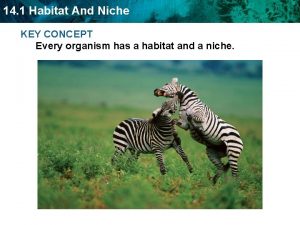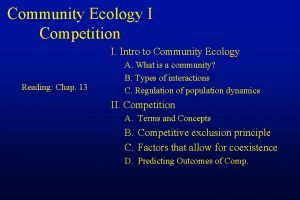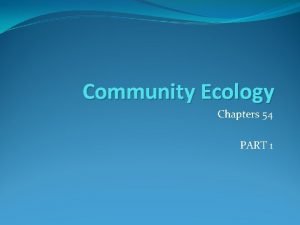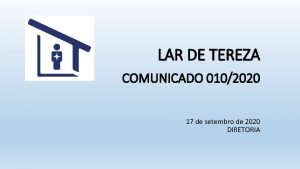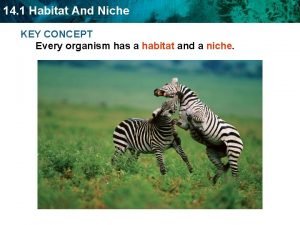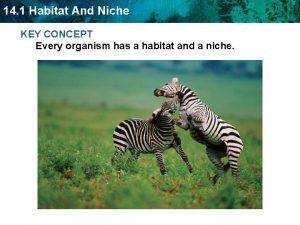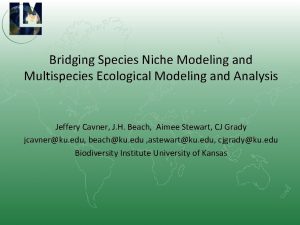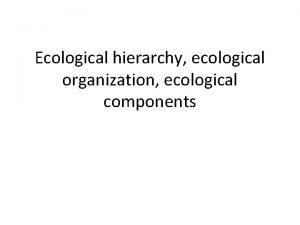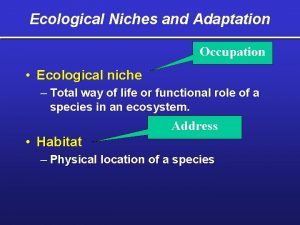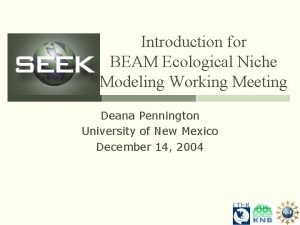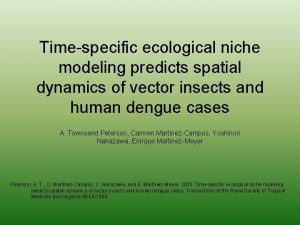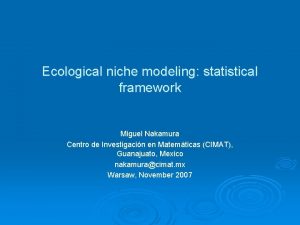Ecological niche and ecological niche modeling Tereza Jezkova




































- Slides: 36

Ecological niche and ecological niche modeling Tereza Jezkova School of Life Sciences, University of Nevada, Las Vegas March 2010 1

What drives species distributions? • All species have tolerance limits for environmental factors beyond which individuals cannot survive, grow, or reproduce 2

Tolerance Limits. Tolerance and Optimum Limits. Range Environmental Gradient Tolerance limits exist for all important environmental factors 3

Critical factors and Tolerance Limits 4

Critical factors and Tolerance Limits • For some species, one factor may be most important in regulating a species’ distribution and abundance. • Usually, many factors interact to limit species distribution. 5

Critical factors and Tolerance Limits ? • Organism may have a wide range of tolerance to some factors and a narrow range to other factors 6

Specialist and Generalist species. . . 7 Fig. 4 -11, Miller & Spoolman 2009

FUNDAMENTAL NICHE Biotic factors Historical factors REALIZED NICHE Realized environment 8

Tolerance Limits andversus Optimum Range Fundamental realized niche Fundamental (theoretical) niche - is the full spectrum of environmental factors that can be potentially utilized by an organism Realized (actual) niche - represent a subset of a fundamental niche that the organism can actually utilize restricted by: - historical factors (dispersal limitations) - biotic factors (competitors, predators) - realized environment (existent conditions) 9

Tolerance Limits and Optimum Niche shift Range Are niches stable? NO! Realized niche shifts all the time due to • changing biotic interations, • realized environment, • time to disperse Time T 1 Time T 2 Realized Niche Shift 10

• Fundamental niche shift when tolerance limits change due to EVOLUTIONARY ADAPTATION Time T 1 Time T 2 Fundamental Niche Shift 11

Resource Partitioning • Law of Competitive Exclusion - No two species will occupy the same niche and compete for exactly the same resources - Extinction of one of them - Niche Partitioning (spatial, temporal) 12

Niche partitioning and Law of Competitive Exclusion Chthamalus Balanus 13

Niche partitioning and Law of Competitive Exclusion 14

Ecological niche modeling Purpose: · - Approximation of a Species Distribution 15

Ecological niche modeling Purpose: · - Potential Niche Habitat Modeling (Invasive species, diseases) 16

Ecological niche modeling Purpose: · - Site Selection or conservation priority: Suitability Analysis 17

Ecological niche modeling Purpose: · - Species Diversity Analysis 18

Two types: Ecological niche modeling 1. DEDUCTIVE: A priori knowledge about the organism Example: SWRe. GAP http: //fws-nmcfwru. nmsu. edu/swregap/habitatreview/ 19

Ecological niche modeling Two types: 2. CORRELATIVE: Self-learning algorithms based on known occurrence records and a set of environmental variables 20

Occurrence records: - Own surveys (small scale) - Digital Databases (e. g. museum specimens) MANIS (mammals) http: //manisnet. org/ http: //olla. berkeley. edu/ornisnet/ ORNIS (birds) HERPNET (reptiles) http: //www. herpnet. org/ HAVE TO BE GEOREFERENCED (must have coordinates) 21

WORLDCLIM http: //worldclim. org/ Variables: • Temperature (monthly) • Precipitation (monthly) • 19 Bioclimatic variables • Current, Future, Past Resolution: • ca. 1, 5, 10 km Coverage • World 22

Southwest Regional Gap Analysis Project http: //earth. gis. usu. edu/swgap Northwest GAP Analysis Project http: //gap. uidaho. edu/index. php/gap-home/Northwest-GAP Variables: • Landcover Resolution: • ca. 30 m Coverage • western states 23

Natural Resources Conservation Service (NRCS) SSURGO Soil Data http: //soils. usda. gov/survey/geography/ssurgo/ Variables: • Soils Resolution: • ca. 30 m Coverage • USA but incomplete 24

Ecological niche modeling Step 1: occurrence records Step 2: environmental variables Step 3: current ecological niche Step 4: projected ecological niche 25

26

Ecological niche modeling – models from Maxent 27

Problems: Models are only as good as the data that goes into it!!! CALIBRATION MODELS • Insufficient or biased occurrence records • Insufficient or meaningless environmental variables PROJECTION MODELS • Inaccuracies in climate reconstructions • Dispersal limitations • Non-analogous climates • Niche shift (evolution) !!! WRONG INTERPRETATIONS !!! 28

sasquatch blackbear 29

Exercise (work in pairs): • Download museum records for one of nine species • Prepare occurrence data file • Run the program Maxent for current (0 K) and last glacial maximum (LGM) climate • Make maps in Diva. GIS (or Arc. GIS if you have it) • Answer questions on the worksheet This Power. Point is on the website, http: //complabs. nevada. edu/~jezkovat/firefighters/niche_mode lling. ppt so are the 0 K and LGM datasets Detailed instructions are at the end of this Power. Point 30

Species: MAMMALS: Chisel-toothed kangaroo rat (Dipodomys microps) Desert kangaroo rat (Dipodomys deserti) Pygmy rabbit (Brachylagus idahoensis) Pika (Ochotona princeps) Mountain beaver (Aplodontia rufa) REPTILES and AMPHIBIANS: Desert Horned Lizard (Phrynosoma platyrhinos) Coastal Tailed Frog (Ascaphus truei) Long-nosed Leopard Lizard (Gambelia wislizenii) Gila monster (Heloderma suspectum) 31

Download Occurrence Records • • • • Choose either Manis http: //manisnet. org database (mammals) or Herpnet database http: //www. herpnet. org/ (reptiles) Select “Data portals” In Manis, click on any of the three providers (e. g. Ma. NIS Portal at the Museum of Vertebrate Zoology Click “build query” Click “Arctos-MVZ catalog” and scroll down Click on “select a concept” and choose “scientific name” Click on “select a comparator” and choose “contains (% for wildcard) Type in the scientific name (e. g. Dipodomys deserti) Delete number under “Specify record limit” Click on “submit query” WAIT !!! If the server crashes start over again ; ) When the server returns the result of your search, click on “Download tabular results” and save the file into a folder 32

Excel – prepare occurrence records csv. file • • Open downloaded occurrence records in Excel (right-click and use the “open with” function Delete unnecessary rows up front Sort by “coordinate uncertainty” Delete all records with no coordinates or those with coordinate uncertainty more than 5000 meters Delete all columns except the species, latitude and longitude Make sure the column representing the species has the same value in all cells Format the columns representing latitude and longitude as numbers with 4 decimal places (Font – Format cells – Number – 4 decimal places) Save as “. csv “ 33

Maxent • • • Download the 0 K and LGM bioclimatic variables http: //complabs. nevada. edu/~jezkovat/firefighters/0 K. zip http: //complabs. nevada. edu/~jezkovat/firefighters/LGM. zip Unzip each dataset into a separate folder Open Maxent (*. bat file) Import your *. csv file of occurrence records Import the folder with the 0 K bioclimatic variables Check all three fields Indicate the directory with the LGM layers Indicate your output directory Press “Run” 34

Diva GIS • • • Import your occurrence records by selecting: Data -> Import points to shapefile -> From text file (. txt) Add the shapefile representing “states”: Layer –> add layer –> States. shp http: //complabs. nevada. edu/~jezkovat/firefighters/states. zip (unzip first) Import your 0 K model generated by Maxent (your_species. asc) by selecting: Data -> Import to Gridfile ->Single file. Choose “ESRI ascii” of file and “select integer” Repeat for your LGM model (your_species_ccsm. asc) Use the zoom tool to zoom in or out to capture the model well Unclick the LGM model Click on “Design” in the bottom right corner and click “OK” in the top left corner Save as *. bmp file Click on “data” in the bottom right corner, unclick you OK model and check your LGM model. Click on Design and repeat your steps as before 35

BIOCLIMATIC VARIABLES BIO 1 = Annual Mean Temperature BIO 2 = Mean Diurnal Range (Mean of monthly (max temp - min temp)) BIO 3 = Isothermality (P 2/P 7) (* 100) BIO 4 = Temperature Seasonality (standard deviation *100) BIO 5 = Max Temperature of Warmest Month BIO 6 = Min Temperature of Coldest Month BIO 7 = Temperature Annual Range (P 5 -P 6) BIO 8 = Mean Temperature of Wettest Quarter BIO 9 = Mean Temperature of Driest Quarter BIO 10 = Mean Temperature of Warmest Quarter BIO 11 = Mean Temperature of Coldest Quarter BIO 12 = Annual Precipitation BIO 13 = Precipitation of Wettest Month BIO 14 = Precipitation of Driest Month BIO 15 = Precipitation Seasonality (Coefficient of Variation) BIO 16 = Precipitation of Wettest Quarter BIO 17 = Precipitation of Driest Quarter BIO 18 = Precipitation of Warmest Quarter BIO 19 = Precipitation of Coldest Quarter 36
 Fundamental vs realized niche
Fundamental vs realized niche Niche
Niche The lion's ecological niche includes its behavior and
The lion's ecological niche includes its behavior and Can a realized niche be larger than a fundamental niche
Can a realized niche be larger than a fundamental niche Fundamental vs realized niche
Fundamental vs realized niche Helen c. erickson nursing theory
Helen c. erickson nursing theory What is an ecological niche? *
What is an ecological niche? * Niche example
Niche example Competitive exclusion example
Competitive exclusion example Simple definition of niche
Simple definition of niche Relational modeling vs dimensional modeling
Relational modeling vs dimensional modeling Pavel machala
Pavel machala Biografia e nene terezes
Biografia e nene terezes Tereza šarić
Tereza šarić Volaverunt montijo
Volaverunt montijo Tereza neuwirthová
Tereza neuwirthová Tereza zajickova
Tereza zajickova Větev vzor píseň
Větev vzor píseň Marie tereza habsburská
Marie tereza habsburská Lar de tereza
Lar de tereza Tereza drogy
Tereza drogy What is data and process modeling
What is data and process modeling Modeling with quadratic functions
Modeling with quadratic functions Typical process description tools include
Typical process description tools include Teapot stomach in gastric ulcer
Teapot stomach in gastric ulcer Nichedefinition biology
Nichedefinition biology Types of gastric ulcer
Types of gastric ulcer Whats the difference between habitat and niche
Whats the difference between habitat and niche Niche vs mass market
Niche vs mass market Requirements for natural selection
Requirements for natural selection Simulation modeling and analysis law kelton
Simulation modeling and analysis law kelton Sequential decision analytics
Sequential decision analytics Modeling with exponential and logarithmic equations quiz
Modeling with exponential and logarithmic equations quiz What is process modeling in system analysis and design
What is process modeling in system analysis and design System requirements checklist output example
System requirements checklist output example Business process and functional modeling
Business process and functional modeling Business process and functional modeling
Business process and functional modeling


